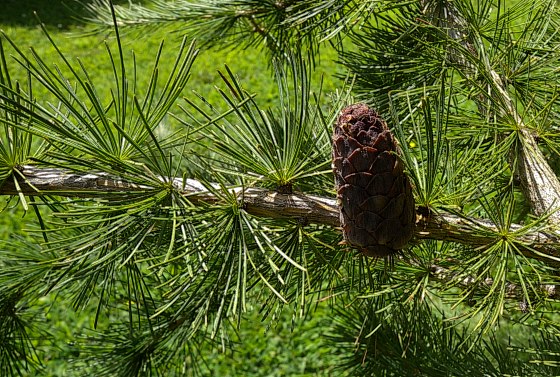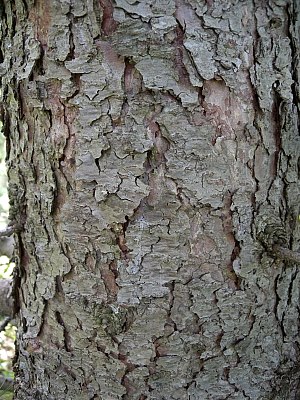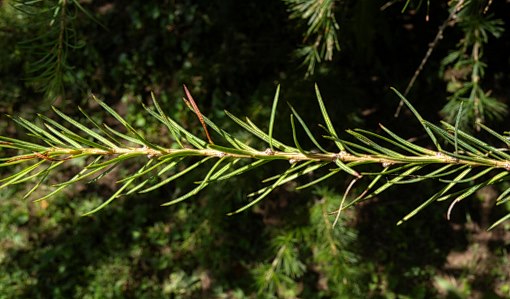Description: This coniferous tree is 30-120' tall, forming an unbranched central trunk with numerous lateral branches. Young trees typically have conical crowns, while older trees are more oblongoid and irregular. Trunk bark of mature trees is brownish or reddish gray and flaky, forming irregular fissures; branch bark is more smooth and gray. First-year twigs (typically 4-20" long) are pale yellow with alternate leaves, while second-year twigs are gray to grayish brown with clusters of 30-60 leaves. Both types of leaves are about ¾-1¼" long, needle-like in shape, and deciduous. During the spring, the leaves are light green, but they later become more dark during the summer. During the fall, they turn yellow before falling to the ground. On second-year twigs, the leaf clusters are produced on short spur-twigs less than 1/8 (3 mm.) long. In each cluster, the leaves are joined together at the base, from which they spread outward in all directions.

European Larch is
monoecious, forming both pollen cones and seed cones on the same tree.
These cones are located toward the tips of second-year twigs during the
spring. At this time of year, the small pollen cones are globoid-ovoid
in shape and yellow, while the larger seed cones are ovoid in shape and
dark red to reddish purple. Pollen cones consist of male (staminate)
flowers and their scales, while seed cones consist of female
(pistillate) flowers and their scales. The cones are cross-pollinated
by the wind. Afterwards, the pollen cones wither away, while the seed
cones continue to develop until they become mature during the fall.
Mature seed cones are ¾-1½" long and ovoid-oblong in shape; they are
initially green from overlapping pubescent scales, but they later
become dark brown and hairless. The seed cones are held more or less
erect and can persist on a tree for more than one year, even after the
seeds have been dispersed. Behind each scale of the seed cone, there is
a broad membranous bract; this bract is shorter than the scale. In
addition to the bract, there is a pair of seeds at the base of each
scale. These seeds have elongated wings and they are dispersed by the
wind. The root system is woody and relatively deep.
Cultivation:
The preference is full sun, moist to mesic conditions, and fertile soil
consisting of loam, sandy loam, or silty loam. Shade and poorly drained
conditions are not well-tolerated. Growth is rapid for young trees and
more slow for older trees. In Europe, longevity of individual trees can
exceed 500 years.

Range &
Habitat:
European Larch has naturalized in NE Illinois, but it is relatively
uncommon (see Distribution
Map). Habitats consist of woodland borders, moist meadows,
edges of yards, roadsides, and abandoned homesteads. This tree was
introduced into North America from Europe, where it is typically found
in mountainous areas. In Illinois, it is used primarily as a landscape
tree.
Faunal Associations:
The caterpillars of several moths feed on Larix spp.
(primarily the leaves): Choristoneura fumiferana
(Spruce Budworm), Coleophora laricella (Larch
Casebearer Moth), Eufidonia notataria (Powder
Moth), Hyalophora columbia (Columbia Silkmoth), Iridopsis
vellivolata (Large Purplish Gray, Macaria
sexmaculata (Lesser Larch Angle), Panthea
acronyctoides (Black Zigzag), Panthea furcilla
(Eastern Panthea), Tolype laricis (Larch Lappet
Moth), and Zale helata (Brown-Spotted Zale). The
larvae of several wood-boring beetles (both Buprestidae &
Cerambycidae) also feed on these trees: Anthaxia aeneogaster,
Callidium violaceus, Melanophila
drummondi, Neoclytus muricatus, Pogonocherus
mixtus, and Tetropium velutinum. Other
insect feeders include Cinara laricifex (Black
Larch
Aphid), Oecanthus laricis (Larch Tree Cricket), Plagiognathus
laricicola (Larch Plant Bug), and Pristiphora
erichsonii (Larch Sawfly). The value of larch to vertebrate
animals is restricted primarily to birds, which eat either the seeds or
buds. These species include Carduelis flammea
(Common Redpoll), Loxia curvirostra (Red
Crossbill), and Loxia leucoptera (White-Winged
Crossbill).

Photographic
Location:
The Arboretum at the University of Illinois in Urbana, Illinois.
Comments: Even
though they both occur in NE Illinois, European Larch doesn't compete
directly with the native Larix laricina (Tamarack)
because the latter species prefers wetter habitats (e.g., swamps
& forested bogs). These two species are very similar in
appearance, but they can be readily distinguished as follows: 1) The
mature seed cones of European Larch are ¾-1½" in length, while those of
Tamarack are only ½-¾" in length, and 2) first-year twigs of European
larch are pale yellow, while those of Tamarack are reddish brown.
Another scientific name of European Larch, Larix larix,
is no longer used.